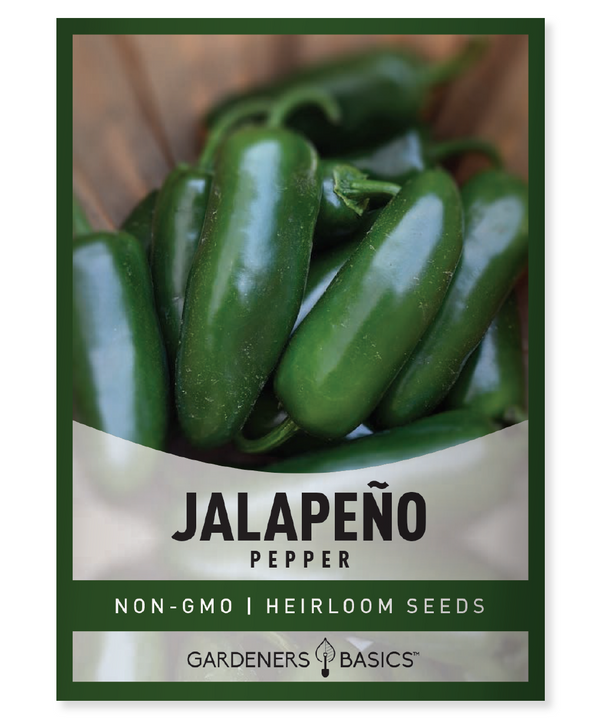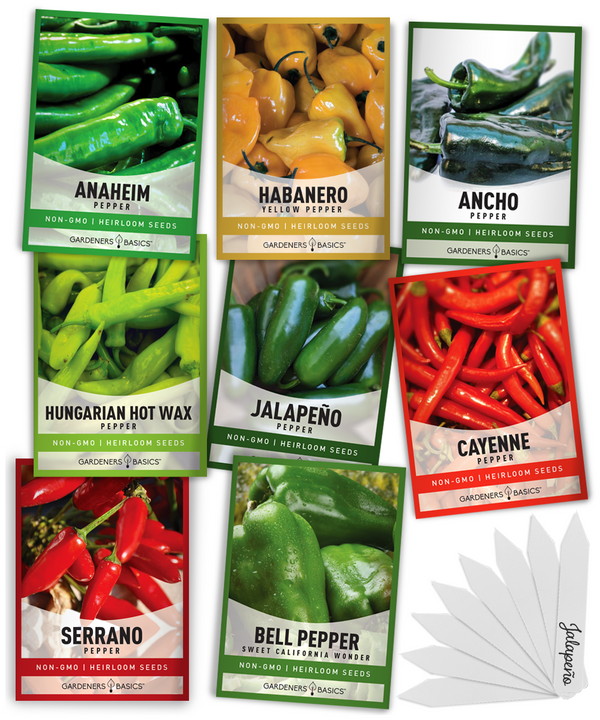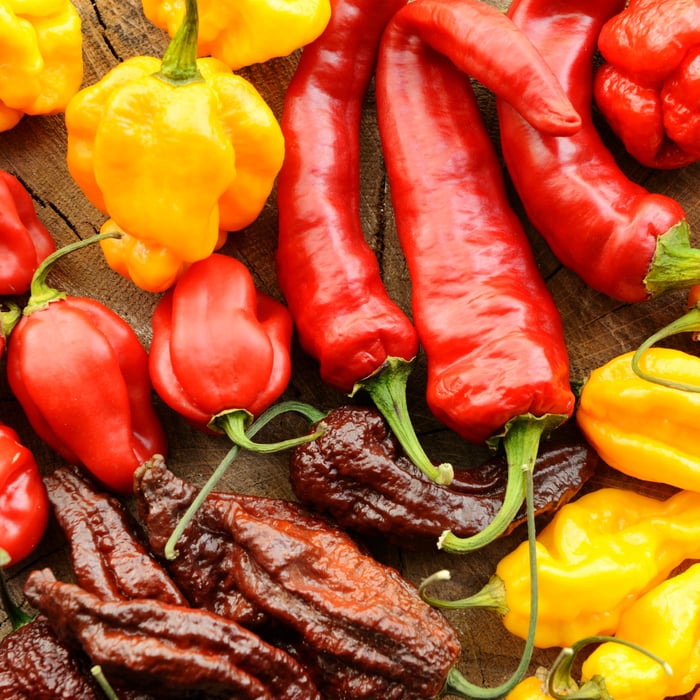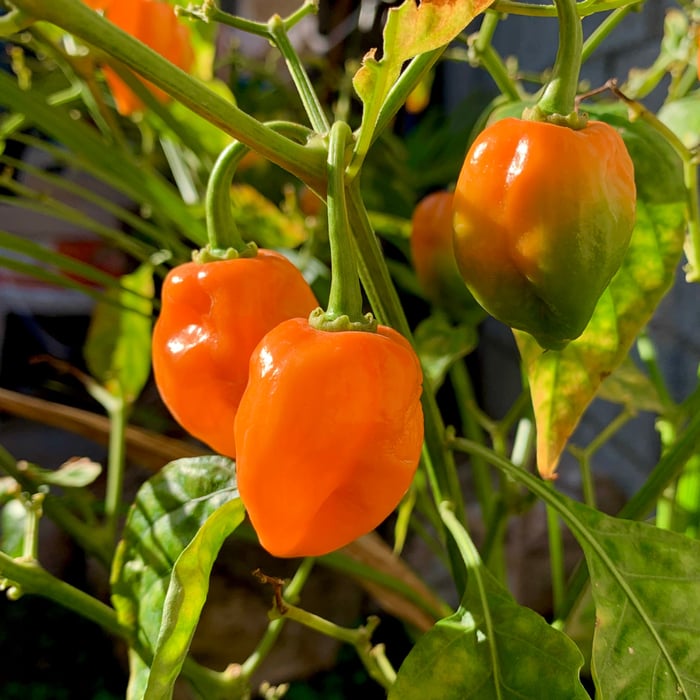Chili peppers have been a staple ingredient in many cultures for centuries. From mild bell peppers to spicy jalapenos, there is a pepper for every taste bud. However, for those who crave the heat, there are some peppers that take the heat to the extreme. In this article, we will explore the hottest peppers in the world, from the popular jalapeno to the fiery Trinidad Scorpion Butch.
The Scoville Scale: Measuring Pepper Heat
Before diving into the world of the hottest peppers, it is important to understand how heat is measured. The Scoville scale, created by American pharmacist Wilbur Scoville in 1912, measures the amount of capsaicin in a pepper. Capsaicin is the chemical responsible for the heat in peppers. The scale ranges from 0 (no heat) to over 2 million (extreme heat). Let's take a look at some of the hottest peppers in the world, starting from the milder end of the scale.
Jalapeño Pepper Seeds

$2.49
Jalapeño Pepper Seeds - Heirloom, Non-GMO, Open Pollinated, Non-Hybrid & Planting & Growing Guide Looking for premium Jalapeño Pepper Seeds? Our seeds are heirloom, non-GMO, non-hybrid, and open-pollinated, ensuring top-quality, reliable growth. Jalapeños are a favorite among gardeners and chefs… read more
Jalapeno Pepper
The jalapeno pepper is a popular chili pepper known for its mild heat. It is commonly used in Mexican cuisine and can be found in most grocery stores. The Scoville rating for a jalapeno pepper ranges from 2,500 to 8,000 SHU.
Habanero Pepper
The habanero pepper is a hot pepper that is commonly used in Caribbean and Mexican cuisines. It has a fruity flavor and is known for its intense heat. The Scoville rating for a habanero pepper ranges from 100,000 to 350,000 SHU.
Scotch Bonnet Pepper
The scotch bonnet pepper is another hot pepper commonly used in Caribbean cuisine. It is similar in heat to the habanero pepper but has a sweeter flavor. The Scoville rating for a scotch bonnet pepper ranges from 100,000 to 350,000 SHU.
Bhut Jolokia Pepper
The bhut jolokia pepper, also known as the ghost pepper, was once considered the hottest pepper in the world. It is native to India and has a sweet and fruity flavor followed by intense heat. The Scoville rating for a bhut jolokia pepper ranges from 800,000 to over 1 million SHU.
Pepper Seed Assortment | 8 Variety Pack

$15.95
8 Pepper Seeds Variety Pack – Heirloom, Non-GMO, Open-Pollinated, Non-Hybrid Seeds Elevate your garden with our 8 Pepper Seeds Variety Pack! This premium selection includes a mix of heirloom, open-pollinated, non-hybrid, non-GMO pepper seeds, perfect for beginner and experienced gardeners.… read more
Trinidad Scorpion Butch Pepper
The Trinidad Scorpion Butch pepper is a hot pepper that was once recognized by Guinness World Records as the hottest pepper in the world. It has a sweet and fruity flavor and is known for its intense heat. The Scoville rating for a Trinidad Scorpion Butch pepper ranges from 800,000 to over 1.4 million SHU.
Pot Pepper
The pot pepper, also known as the pot brain strain, is a hot pepper that is a cross between the Trinidad Scorpion Butch and the Douglah pepper. It has a fruity and smoky flavor and is known for its extreme heat. The Scoville rating for a pot pepper ranges from 1.2 million to over 2.2 million SHU.
Naga Morich Pepper
The Naga Morich pepper, also known as the serpent pepper, is a hot pepper native to Bangladesh and Northeast India. It has a citrusy and floral flavor followed by intense heat. The Scoville rating for a Naga Morich pepper ranges from 1 million to over 1.5 million SHU.
Pot Primo Pepper
The pot primo pepper is a hot pepper that is a cross between the Trinidad Scorpion Butch and the Naga Morich pepper. It has a sweet and fruity flavor followed by intense heat, and is known for its extreme heat. The Scoville rating for a pot primo pepper ranges from 1.3 million to over 1.5 million SHU.
Hottest Peppers in the World
Now that we've explored some of the hottest peppers in the world, let's take a look at the top contenders for the title of "hottest pepper".
Carolina Reaper Pepper
The Carolina Reaper pepper is a cross between a Pakistani Naga pepper and a Red Habanero pepper. It was created by Ed Currie of the PuckerButt Pepper Company in South Carolina and was recognized by Guinness World Records as the hottest pepper in the world in 2013. The Scoville rating for a Carolina Reaper pepper ranges from 1.5 million to over 2.2 million SHU, making it one of the hottest peppers in the world.
Pepper X
Pepper X is a pepper created by Ed Currie of the PuckerButt Pepper Company. It has not yet been recognized by Guinness World Records as the hottest pepper in the world, but it is rumored to have a Scoville rating of over 3 million SHU.
Dragon's Breath Pepper
The Dragon's Breath pepper is a pepper created by Mike Smith of Tom Smith Plants in Wales. It has not yet been recognized by Guinness World Records as the hottest pepper in the world, but it is rumored to have a Scoville rating of over 2.4 million SHU.
Pepper Seeds and Pepper Seed Varieties
If you're interested in growing your own hot peppers, there are many pepper seed varieties available on the market. Here are a few popular options:
Ghost Pepper Seeds
Ghost pepper seeds, also known as bhut jolokia seeds, are a popular choice for those who want to grow their own extremely hot peppers.
Trinidad Scorpion Butch T Seeds
Trinidad Scorpion Butch T seeds are another popular choice for those who want to grow their own hot peppers. They produce peppers with a sweet and fruity flavor followed by intense heat.
Carolina Reaper Seeds
Carolina Reaper seeds are a popular choice for those who want to grow the hottest pepper in the world.
Hot Sauces
If you're not interested in growing your own hot peppers, there are still many ways to enjoy the heat. Hot sauces are a popular way to add heat to any dish. Here are a few popular hot sauces:
Tabasco Sauce
Tabasco sauce is a classic hot sauce that has been around since 1868. It is made from tabasco peppers and has a vinegary flavor with a moderate amount of heat.
Sriracha Sauce
Sriracha sauce is a hot sauce that originated in Thailand. It is made from chili peppers, vinegar, garlic, sugar, and salt, and has a sweet and spicy flavor.
PuckerButt Pepper Company Hot Sauces
The PuckerButt Pepper Company is known for its extremely hot peppers, and their hot sauces are no exception. Their hot sauces range from mild to extremely hot, and are made from their own varieties of hot peppers.
In conclusion, whether you're a pepper enthusiast or just looking to spice up your meals, there are many options for those who crave the heat. From the milder jalapeno to the fiery Carolina Reaper, there is a pepper for every taste bud. And if you're feeling adventurous, try growing your own hot peppers or experimenting with hot sauces from around the world. Just remember to handle these peppers with care, as they can cause serious irritation to the skin and eyes.
History of Chili Peppers
Chili peppers have been a part of human diets for thousands of years. They were first domesticated in the Americas around 7500 BCE and were cultivated by various civilizations, including the Maya, Aztecs, and Incas. The spread of chili peppers around the world was due to the Portuguese and Spanish explorers, who brought them to Europe and Asia in the 16th century. Today, chili peppers are grown and consumed in many parts of the world and have become a staple ingredient in various cuisines.
How to Handle Hot Peppers
When working with hot peppers, it is important to take precautions to avoid irritation to the skin and eyes. Here are some tips on how to handle hot peppers:
- Wear gloves to protect your skin from the capsaicin in the peppers.
- Avoid touching your face or eyes while handling hot peppers.
- Wash your hands thoroughly after handling hot peppers.
- If you accidentally get hot pepper juice in your eyes, rinse with cold water immediately.
Health Benefits of Chili Peppers
In addition to adding flavor and heat to your meals, chili peppers also offer various health benefits. Here are some of the health benefits of chili peppers:
- They are high in vitamin C, which can help boost the immune system.
- They contain capsaicin, which has been shown to have anti-inflammatory properties.
- They can help relieve pain by blocking the pain receptors in the body.
- They may help improve digestion by increasing the production of digestive enzymes.
Puckerbutt Pepper Company
The Puckerbutt Pepper Company, founded by Ed Currie, is a company that specializes in growing and selling extremely hot peppers. In addition to creating the Carolina Reaper, the company also offers a variety of other hot peppers, hot sauces, and pepper seeds.
Guinness World Records for Hottest Peppers
Guinness World Records has recognized several peppers as the hottest in the world over the years. Here are some of the peppers that have held the title of hottest pepper:
- Bhut Jolokia (2007-2010)
- Naga Viper (2011)
- Trinidad Scorpion Butch T (2011-2013)
- Carolina Reaper (2013-present)
Culinary Uses of Hot Peppers
Hot peppers are used in a variety of cuisines around the world. Here are some popular dishes that feature hot peppers:
- Mexican salsa and guacamole, which often contain jalapeno or serrano peppers.
- Indian curries, which often contain hot peppers like bhut jolokia or naga morich.
- Caribbean jerk chicken, which is marinated in a spicy mixture that includes scotch bonnet peppers.
- Thai dishes like tom yum soup, often contain bird's eye chili peppers.
Growing Hot Peppers
If you're interested in growing your own hot peppers, there are a few things to keep in mind. Here are some tips for growing hot peppers:
- Choose a sunny location with well-draining soil.
- Start the seeds indoors 6-8 weeks before the last frost.
- Transplant the seedlings outdoors after the last frost.
- Fertilize the plants every 2-3 weeks with a balanced fertilizer.
- Harvest the peppers when they are fully mature and firm to the touch.
The Future of Hot Peppers
As interest in hot peppers continues to grow, researchers and breeders are working to create even hotter peppers. Some experts predict that we may eventually see peppers with Scoville ratings of 4 or 5 million SHU. However, it is important to remember that extreme heat comes with risks, and handling and consuming these peppers should be done with caution.
Hot Pepper Challenges
In recent years, hot pepper challenges have become a popular trend on social media. These challenges involve eating extremely hot peppers or hot sauces and filming the reaction. While these challenges can be entertaining to watch, they can also be dangerous. Consuming extremely hot peppers or sauces can cause gastrointestinal issues, vomiting, and even hospitalization in some cases.
Hot Peppers in Pop Culture
Hot peppers have made appearances in various forms of pop culture, from movies and TV shows to music and literature. Here are some examples:
- The 1999 movie "Chili Palmer" featured a character named Chili Palmer who was obsessed with hot peppers.
- The animated TV show "Rick and Morty" features a character named Scary Terry who is a parody of horror movie characters and has hot sauce stains on his shirt.
- The song "Red Hot Chili Peppers" by the band Red Hot Chili Peppers is named after the band's love of spice and features lyrics about the heat of peppers.
- The book "Chocolat" by Joanne Harris features a character named Vianne who uses chili peppers in her chocolate recipes.
Hot Pepper Festivals
Hot pepper festivals have become popular events in many parts of the world. These festivals typically feature hot pepper tastings, contests, and live music. Here are some popular hot pepper festivals:
- The Hatch Chile Festival in New Mexico celebrates the harvest of Hatch chile peppers, which are known for their mild heat and fruity flavor.
- The Louisiana Hot Sauce Expo in Baton Rouge features a variety of hot sauces from around the world.
- The NYC Hot Sauce Expo features a hot sauce eating contest and a variety of hot sauces and spicy foods.
Conclusion
Hot peppers are a fascinating and versatile ingredient that have been enjoyed by humans for thousands of years. From mild jalapenos to extreme pot peppers, there is a pepper for every level of heat tolerance. Whether you're growing your own hot peppers, experimenting with hot sauces, or just enjoying the occasional spicy dish, it's important to remember to handle these peppers with care and respect their heat.
Frequently Asked Questions:
- What makes hot peppers hot ? Hot peppers get their heat from a chemical called capsaicin. Capsaicin stimulates the pain receptors in your mouth and causes a burning sensation.
- What is the Scoville scale? The Scoville scale is a measurement of the heat in chili peppers. It ranges from 0 (no heat) to over 2 million (extreme heat).
- What is the hottest pepper in the world? The Carolina Reaper pepper is currently recognized as the hottest pepper in the world by Guinness World Records, with a Scoville rating of over 2 million SHU.
- Are hot peppers good for you? Yes, hot peppers offer several health benefits, including boosting the immune system, relieving pain, and improving digestion.
- What are some popular hot pepper varieties? Some popular hot pepper varieties include jalapeno, habanero, scotch bonnet, Trinidad Scorpion Butch, and the Carolina Reaper.
- Can you get sick from eating hot peppers? Consuming extremely hot peppers or sauces can cause gastrointestinal issues, vomiting, and even hospitalization in some cases. It is important to handle and consume hot peppers with caution.
- How do you reduce the heat in hot peppers? To reduce the heat in hot peppers, you can remove the seeds and membrane, which contain the highest concentration of capsaicin. You can also pair hot peppers with cooling ingredients like dairy products or citrus fruits.
- How do you store hot peppers? Hot peppers can be stored in the refrigerator for up to a week or in the freezer for several months. It is best to store them in a plastic bag or container to prevent moisture loss.
- How do you grow hot peppers? Hot peppers can be grown from seeds indoors or outdoors in a sunny location with well-draining soil. They should be fertilized every 2-3 weeks and harvested when fully mature and firm to the touch.
- What are some popular hot sauce brands? Some popular hot sauce brands include Tabasco, Sriracha, and the PuckerButt Pepper Company.
- How is capsaicin pronounced? Capsaicin is pronounced, "kap-SAY-uh-sin".








